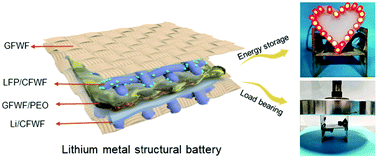Lithium metal structural battery developed with vacuum bagging†
Abstract
Development of structural batteries having outstanding energy storage and load carrying abilities simultaneously is promising to accelerate the light-weighting of automobile and aviation industries. Here, the fabrication of a lithium metal structural battery (LMSB) based on Li/carbon fiber woven fabric (CFWF) anode, LiFePO4/CFWF cathode, glass fiber woven fabric (GFWF)/PEO electrolyte and GFWF/epoxy pack is demonstrated for the first time with a simple vacuum bagging process. The LMSB with lithium metal as anode exhibits a high discharge capacity of ∼147 mA h g−1, which is close to the theoretical specific capacity of LiFePO4 particles. The LMSB also demonstrates prominent mechanical properties including a tensile strength of 168.4 MPa and a bending strength of 157.8 MPa due to the extraordinary mechanical performance of CFWF and GFWF. Meanwhile, the GFWF/PEO electrolyte developed plays multiple roles, besides the essential function of conducting Li+, also serving as a protection layer of the Li anode to isolate from air, which enables the successful fabrication of the LMSB with a technique compatible with conventional composite forming. Furthermore, the fabricated LMSB exhibits reliable charge–discharge performances after moderate mechanical loading including bending, tension and compression. Considering the excellent load-bearing and electrochemical energy storage performances, combined with the facile vacuum bagging process suitable for large-scale fabrication, the LMSB developed should have a great potential in next-generation electric vehicles and electric aircraft.



 Please wait while we load your content...
Please wait while we load your content...